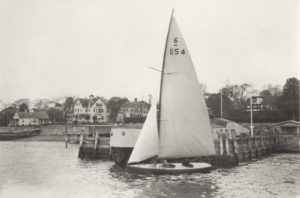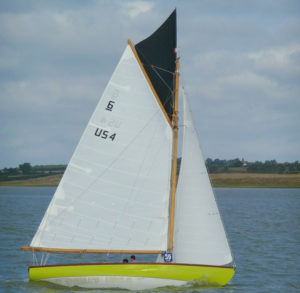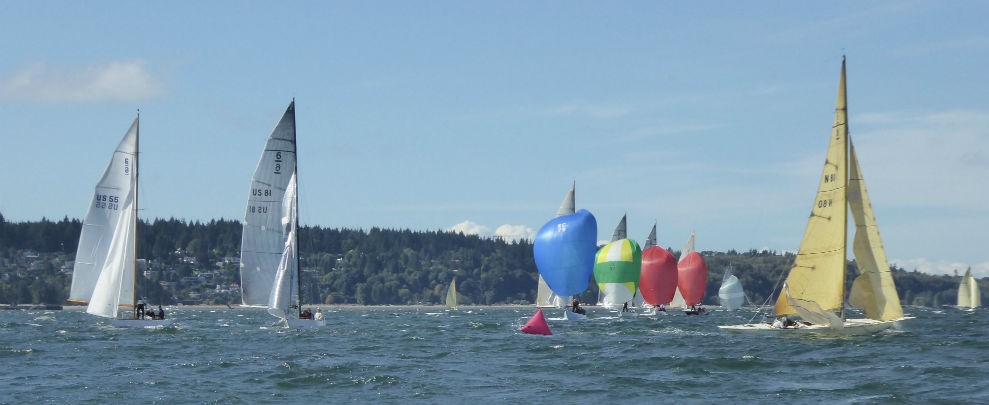The boats that sailed a century ago – part 4: Sheila
June 15th, 2021
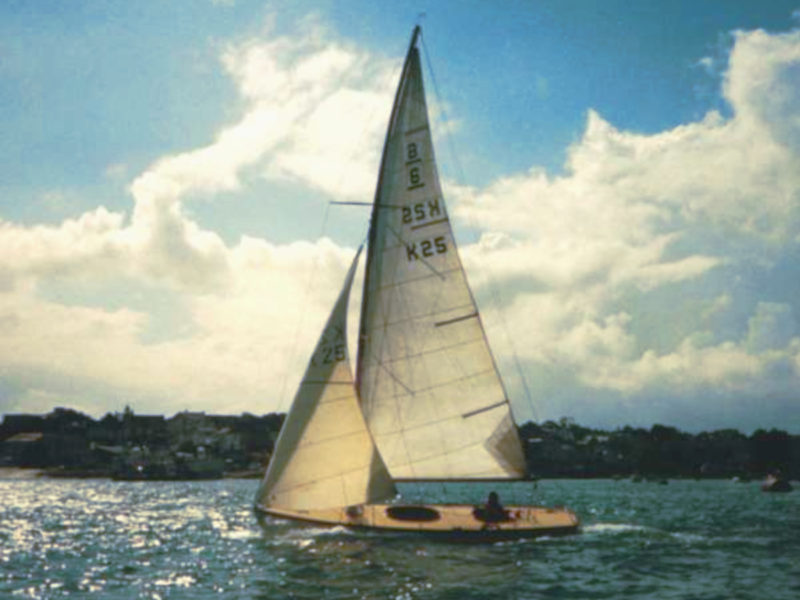
100 years of racing
2021 is the centenary year of the British American Cup, the first major trophy for international team racing. The competition was hugely popular and was a further boost for the increasingly successful International Six Metre Class.
The eight entrants in 1921 – four each for Britain and America – were launched in the same year.
This is the fourth in a series of posts to mark the centenary of the launch of the eight pioneering international team racing boats. Our fourth instalment explores the story of Sheila.
The American team – Sheila
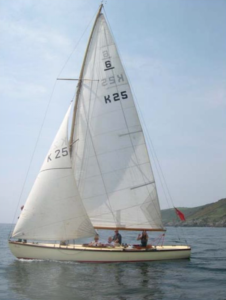
Sheila has a distinctive hull shape – quite different from other Six Metres of her age. Image from archive record DNTS.1.10
Classic yachts carry with them a great amount of history. The history of a boat is tied intrinsically to the history of all the lives that boat touches – the owners, the crew, designers, and builders. We have seen so far in this series that this is especially true of Six Metre Class yachts and this is no less the case with the 1921 Burgess designed Sheila.
Sheila was the first yacht built by the Herreshoff Manufacturing co. that was not designed by Captain Nat. Herreshoff himself. Sheila’s designer Starling Burgess was a naval architect and aviation pioneer; the archetypal early twentieth century polymath and innovator. He was not as familiar with the European International Rule boats as his fellow countryman, designer of Grebe, William Gardner so it is no surprise then that sailing literature throughout the twentieth century records Sheila as an unorthodox Six. But therein lies her charm. And whilst six of the original eight entrants to the 1921 British American Cup are no longer with us, are in poor condition, or are missing from the records, Sheila is not only sailing but is in fine health – a testament perhaps to her design and build.
Current owner Dan Tester agrees. “Part of the reason she’s still alive has to be down to the builder. The materials that she’s built with are a hundred years old and are phenomenally good. All the Honduras planking is still there, still got its colour, it’s still fastenable, it doesn’t move, she’s still sat outside now and there’s not a crack in it. She’s just solid… testament to the builders. They did such a lovely job. Herreshoff were the best without a doubt which is a another reason to buy her. If you buy right you know you’ve got a lifetime’s use.”
Sheila was built for Paul Hammond in 1921. Hammond had earlier founded a merchant bank in 1903 in New York City, which would eventually become Hammond Kennedy Whitney (HKW), which still operates to this day.
It is very likely that it never would have started if Mr. Hammond had not had a strong determination.
Paul Hammond’s life – including his military and professional career and his sailing adventures are well documented; he served in the US Naval Reserve in the First and Second World Wars as well as winning the Transatlantic Ambrose Lightship Race between New York and Santander in 1928. But perhaps, however, his greatest contribution to the world of sailing is less well known. Paul Hammond was almost single handedly responsible for founding the British American Cup.
Excerpts from a letter written by L Francis Herreshoff to Robert D Shultz in 1961, which has already been a valuable insight into the competition for this series of posts, shows Herreshoff’s respect for Hammond who had discussed the idea of a competition between small racing vessels with British Naval officers while on leave.
“It is very likely that it never would have started if Mr. Hammond had not had a strong determination and a lot of patience, together with the personal contacts with the British yachtsmen…”
“Mr Hammond had a difficult job to persuade Americans to build four boats, but he did this, so far as I can remember, single-handedly.”
The races
Sheila was helmed by one of the most famous sailors of his day, Sherman Hoyt, who recalled in his memoirs:
“…all except Grebe were generally outclassed by our opponents. On the other hand it was the first of my many protracted visits to my beloved Cowes where I renewed old and acquired many new friendships. We were received with open arms and rather to our surprise, but to our gratification, were issued cards to the Royal Yacht Squadron, the Royal London Yacht Club and the delightfully friendly and more informal Island Sailing Club.
“We on Sheila — Hammond, “Bubbles” Havemeyer and I — were lucky in enlisting as our fourth member, Joe Hannen, versed in local conditions and destined in years to come to be one of my best friends, were not unduly handicapped in the racing.”
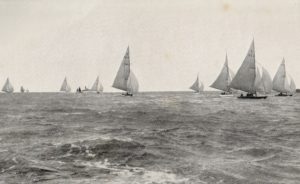
Six Metres racing at the 1921 British American Cup. Sheila, with her US4 sail number, can be seen in the centre of the image. Photograph from “At the Tiller” by Iain Rutherford.
Despite his assertion that they were not unduly handicapped, a number of elements went against Hammond and Hoyt in the races. On arriving in Britain Sheila was remeasured and was found not to meet the International Rule. A minor difference between the way she was measured in Britain and America made a big difference. Her sail area was required to be reduced and she effectively sailed with a reefed main.
In the first race, in which only Grebe finished for the Americans, Sheila was dismasted in bad weather and dropped out. Further issues caused her to not finish the third and fourth race. She finished the second and fifth race in third and the final race in fifth. Though her total points tally was the lowest of all eight boats, her average placing for the races finished was the fifth highest of all and second highest of the American boats.
Hoyt would go on to co-design the Six Metre Lea, which he would race quite successfully in the British American Cup competitions of 1922, 1923 and 1924.
Sheila’s unusual appearance was owing to her very short ends and a tall, bent mast – a design element which was in fact outlawed in the class the following year, but which she kept until very recently.
After the British American Cup
Lloyd’s Register of Yachts lists six owners after Paul Hammond between 1923 and 1934 and variously registered in west Scotland with the sail number K25. Whilst researching the history of Sheila, Tim Street provided some notes:
“She raced with the Clyde fleet, dropping down to the Number II Cup, then subsequently racing in the Clyde Fortnight with the ex-Six-Metre Class. At some stage in the mid-30s, she was turned into a cruiser and cruised the Hebrides, certainly until 1960 when I first saw her at Tobermory. She made several trips out to St. Kilda. I next saw her again in I think 1986 at Cowes, on a slipway, where I was shown her by her then owner, a retired Lt. Comd. She was later sold to the Island Sailing Club at Salcombe, who had her turned back into her original configuration for sail training.”
Sheila was the subject of the book At the Tiller by then owner Ian W. Rutherford, published by Blackie & Son in 1945 after the Second World War. Words in his introduction may strike the reader as particularly pertinent to the global situation in 2020 and 2021:
“For over six years our boats have been laid up in the scattered yards round our coasts, and we have had only our memories, backed up by a few good books, to carry us on to the time when once again we will feel the pull of a tiller in our hands.”
The book describes Rutherford’s experiences of buying Sheila (which he renamed Suilven) as a young man and cruising from Scotland as far as Norway and north-west Ireland. He describes the boat: “With her short ends and amazingly lofty mast she had always appeared rather a freak among the more conventional yachts. Her bow had only 2 ½ feet of overhang, while her counter was sawn off 1 ½ feet from the waterline, the effect being to make her not unlike an overgrown dinghy.”
Sheila today
Sheila is today owned by Dan Tester and kept in Kent. Mr Tester gave a detailed account of his time with Sheila and the modifications her has carried out:
“I was at an Old Gaffer’s meeting once with a 20ft keel boat converted to a gaff and having seen what this little boat could do and having not been able to start I thought I’d like a bigger boat, something I could put some real power into. So I started looking for a Six Metre boat, with my sail maker with me, who would draw the boat, to find out if we could balance a gaff rig on it.
“Most of them required a bowsprit which I wasn’t prepared to do. What I really wanted was a boat that I could interchange with a Burmudan and a gaff. Sheila was designed originally with such a huge main sail that it kind of represented a gaff main sail. Believe it or not when we balanced her up down in Plymouth she actually balanced on paper reasonably well with the same mast position. So we bought her and set about making a gaff rig.
“I wanted to set out to prove that I could get this boat racing with a gaff rig, and be not only competitive but capable of beating them. I have a lot of experience of building hollow wooden spars and creating lightness and strength. So I made a mast which was 5 inches in diameter, 34 foot long. Made from wood.
“My father was a clever chap. And he didn’t ever work anything out mathematically but he knew by looking at something whether it was right or wrong. He said to me as soon as I put the mast in “You’ll break that”. I said “Oh, we’ll see.” So I tentatively sailed her for the first year or so and it seemed okay. It would put up with pretty much everything I threw at it.
“There’s a race series up on the east coast called Mersea Week. Two hundred boats or so of various shapes and sizes take part. We went and did that week and on the Friday we were in a lot of wind. We had the kite up on a shy reach and the spinnaker was starting to fold. And although the mast seemed quite stable, we dropped the kite and got to the lower mark and hardened in and we just couldn’t harden the main sail in. It just kept flapping. And it wasn’t until we looked up and saw this awful bend in the mast. So my father’s prophecy came true! And of course I was rather disappointed.
“But reading back about Sheila’s history she had a bit of a habit of breaking masts even though she was designed by a top bloke.
“Part of the reason I bought her was because of the short ends. What would almost steer me away from a Six was the long overhangs because up here on the east coast we get lots of short sharp sea and I’ve seen many Sixes race up and literally tear themselves up to bits.
“So Sheila has a larger displacement but shorter ends. The underwater shape is lovely. And she’s got three and a half tons of lead! I’ve never ever pressed the decks in the water in this boat. Ive had water on decks but Ive never pressed the decks in the water. There’s an Uffa Fox book with a snippet on Sheila. She was noted as being really fast in lots of wind, but of course you don’t get that in a weeks’ racing in the British American Cup, you take what you’re given.
“I built a new mast with a bigger diameter and I’ve extensively tried it. It’s hard to judge her against others because she’s a one off. There’s a Six Metre called Maida. She has a fairly modern rig and sails, and they’re very equally matched. In moderate conditions, Maida would have the edge, but in harsher conditions Sheila would walk away with it. Most of my races were against West Solent One designs. They’re similar tonnage and shape and rig to a traditional Six but they 36ft long so obviously waterline, they’d have an advantage through the water, especially through a run or a reach but I up wind 50% of the time in a moderate breeze I would beat them but in a stiff breeze I’d be nowhere to be seen, I’d just sail away from them. Up wind, down wind, whatever you want, she would just sail away.
“She’s probably got a bit more draft. With the refit, you’re not leaving so much mast up in the air. It’s hard to say whether the gaff rig is better than the Bermudan rig. The current gaff rig that she holds is definitely better than her original Bermudan rig. But I reckon if I was to build a proper Bermudan fractional rig made from modern materials, it would probably be better. Because they just are, that’s evolution. But that wasn’t my aim. I wanted to show that they aren’t far off if you do a gaff rig properly.
“She’s a smart little boat. I don’t think there’s another 27ft gaff rig boat anywhere that would stay with her. And if someone was to buy it and take it down the Mediterranean and race her under a local handicap, they would clean up, absolutely clean up because she punches so far above her weight, it’s untrue!”
Thanks to Tim Street for his knowledge and to Dan Tester for his time and stories. Sheila has been repainted white as originally built; rubbing bands, rails, ring frames, all screws, fixings and fastenings have all been refastened and replaced. In Dan Tester’s own words, “she’s a nice tight ship now!” Dan has taken on his father’s business and no longer has time to sail Sheila as much as he would like to so he has made the decision to put her up for sale.
Posted in Anniversary by James Harris on June 15th, 2021. Tags: British American Cup, Flya, Sailing, Six Meter, Six Metre, William Fife
Subscribe to comments | Both comments and pings are currently closed.
We need your support
Support our project and submit your records or make a donation to the International Six Metre Archive.
